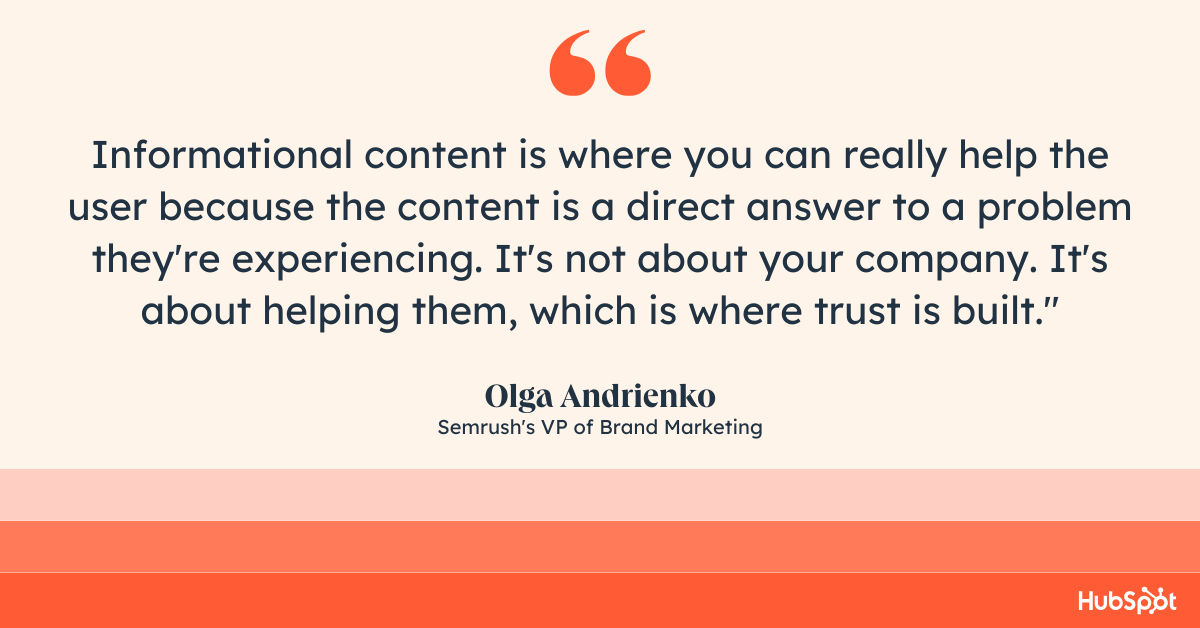Having a strong SEO strategy is critical for reaching new audiences and generating leads for your business.
In fact, 43% of marketing directors, VPs, and C-suite executives reported SEO as one of the most effective strategies their companies currently leverage.
Creating a powerful SEO strategy requires consistent testing and iteration. Over time, certain metrics can help you identify which areas of your strategy are working — and which aren’t.
It can be difficult, however, to determine which SEO metrics actually matter. To truly evaluate the success of your SEO, what should you pay attention to? Organic traffic? Leads? Keyword rankings? Conversions?
Here, I sat down with Semrush’s VP of Brand Marketing, Olga Andrienko, to discuss the SEO metrics she’d advise leaders pay attention to in 2023. Let’s dive in.
The SEO Metrics That Matter Most, According to Semrush’s VP of Brand Marketing
1. Focus on the metrics that tie directly back to revenue — like conversions and new MRR.
You might’ve expected Andrienko to start with organic traffic or rankings as a top SEO metric, but instead, she advises leaders to start with the bottom line — revenue — and work backwards.
Andrienko told me, “When we discuss quarterly goals, we always look at new user monthly recurring revenue (new MRR). And, in that case, conversion is the only thing that matters. I think the metrics that matter are the ones that can tie back directly to revenue.”
She adds, “For instance, using analytics, you can see where the user came from, and how long it took them to convert and become a customer. So if we know most users come from organic search, then organic would be the metric I’d be focused on measuring. Whatever your success element is is the most important outcome. Rankings don’t matter much. People need to land on your website, and they need to buy or show they’re interested.”
Hearing ‘rankings don’t matter much’ from the VP of Brand Marketing at Semrush, a platform often used for online ranking data, initially surprised me. But it makes sense.
Let’s say you rank #1 for the keyword query: “What is marketing?” If your company sells products or services related to marketing, that’s great. But if that same post isn’t driving the right kind of traffic, or isn’t converting that traffic into qualified leads and revenue for the business … Does it matter, really?
Focusing on the metrics that tie back to revenue can greatly impact where you spend your time and resources. To effectively evaluate your content based on revenue, consider making a spreadsheet that tracks all your top-converting posts. Even if those posts aren’t the ones that bring in the most traffic for your site, those are the posts you’ll want to focus your historical optimization attention on — since those have proven most valuable to your business’ bottom line.

2. Don’t forget about branded keyword search volume.
Andrienko admits this next metric likely matters to her because of her role as a brand marketing leader, but it’s worth mentioning since it’s a metric that can demonstrate your brand value.
As she puts it, “For me, being a brand marketing leader, I specifically focus on branded keyword search volume — which means how many impressions and search volume the keyword ‘Semrush’ is getting over time. That gives me an understanding of how good we are at strengthening the brand and growing brand awareness.”
This is a particularly important metric if your goal is to grow brand awareness for your business. As you test strategies meant to increase brand awareness, such as co-marketing campaigns, sponsored events, or new types of content like podcasting, you’ll want to obsess over branded keyword search volume. Is it going up over time? If it is, this is a strong indicator that your brand awareness strategy is working.
While this can seem like a more superficial metric, it’s not. Consumers want to buy from companies they trust — and familiarity is a powerful factor when it comes to developing trust with your prospects.
3. Consider click-through rate and how it correlates to organic traffic.
“If you see a lot of people are searching for select keywords, but your CTR isn’t growing, then that means something is off,” Andrienko told me.
She continues, “For instance, we noticed the organic CTR on one of our keywords was dropping, and we discovered it was because Google added an AdWords top search feature — so we bid on the keyword. Ultimately, we saw that even though organic CTR was dropping, we were able to get the clicks anyway in a different form.”
“It’s important you don’t just look at organic traffic … But also how it correlates with the click-through rate. That’s a very important connection to make.”
In a world where almost two-thirds of Google searches end without a click, it has become increasingly difficult to achieve high click-through rates. And Andrienko admits it’s not always feasible. Consider, for instance, a user who searches “How can I measure click-through rate?” They’ll be shown this featured snippet, which concisely answers their query:

This is where the power of long-tail keywords comes into play.
Andrienko told me about one of Semrush’s customers, a dentist. After struggling for a while with attracting audiences to his website, the dentist decided to search for any dental-related queries. Then, he took those keywords, grabbed a recorder, and went to his doctors. After recording their answers to his questions, he put them up on his blog and started ranking for the long-tail keywords related to his industry.
While this strategy might not work for everyone, it’s worth noting that creating content that requires users’ to click on the link to get the full benefits is critical for optimizing your SEO strategy.
For instance, rather than writing a post that answers the query “how can I measure click-through rate?”, you might also create content that answers more long-form queries, like “What are the best strategies to increase CTR?”.
Informative, helpful content that leverages long-tail keywords isn’t just for attracting audiences. It’s also vital for building trust and creating stronger relationships with your audience. In fact, Andrienko told me her favorite type of content is informational. “It’s where you can really help the user because the information is a direct answer to a problem they’re experiencing. It’s not about your company. It’s about helping them, which is where trust is built.”

4. Don’t ignore rankings, backlinks, domain authority, and user behavior metrics.
Finally, Andrienko provided a list of a few other metrics that she believes still deserve a mention in this post.
For one: Rankings and positions.
She told me, “I wouldn’t focus on rankings and positions as the first metric, but you still need to see how you’re performing against competitors. So it’s an important day-to-day metric to watch.”
A few other metrics Andrienko encourages leaders to watch:
- Backlinks
- Domain authority
- User behavior metrics, like page load speed
There are other metrics she uses for more qualitative purposes too, like bounce rate. She says, “Bounce rate is important to track because it indicates whether the content is actually interesting and compelling to your readers.”
She continues, “And pages per session is another metric you’ll want to pay attention to — because let’s say users land on ‘What is SEO?’. We know they won’t immediately convert on that page. We need to encourage them to go to another page, and another page after that, so we’re able to grab their attention and ultimately convert them. If they only visit one page per session, it means we didn’t do a good job of retaining them.”
The SEO metrics you care about ultimately depends largely on your goals as a marketing leader. As you approach 2023, you’ll want to consider your goals, and then work backwards from there to identify which SEO metrics will help you evaluate how aligned your strategy is with those goals.
Not sure which goals to focus on? Take a look at The Top Goals of Marketing Leaders in 2023, or find other helpful content related to leadership in 2023 in the post, Act Like a Leader, Think Like a Leader: Data from 300+ Marketing Directors on How to Take Your Team to the Next Level.
![]()

![→ Download Now: SEO Starter Pack [Free Kit]](https://i4lead.com/wp-content/uploads/2022/11/1d7211ac-7b1b-4405-b940-54b8acedb26e.png)
